Optical Units Reference
Multipliers, Optical Power, Gain & Loss, Wavelength & Frequency, and Bandwidth & Optical Modulation Bandwidth
August 1, 2001

Here is your guide to the world of units used within the optical networking industry. This field can be confusing at the best of times, but when it comes to numbers and units the situation can often get critical. Misunderstandings can arise because of the different definitions used in different disciplines, with physics and networking being the culprits here. After reading this reference, however, you will hopefully know your giga from your mega, your dB from your dBm, and your Gbit/s from your GHz – as well as your arse from your elbow.
Multipliers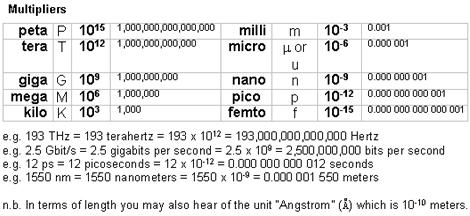 Optical Power
Optical Power
Optical power is usually expressed in Watts (W). For anyone with an interest in physics (don’t laugh, there are some) power is actually energy per unit time, or Joules per second (J/s).
In the field of optical networks, powers can be extremely small, so they will usually be given in units of milliwatts (mW) or decibels relative to a milliwatt (dBm). The dBm unit is commonly used and provides several advantages in calculations that make it easier to work with (see Gain & Loss below).
If you are interested in the math, here are the equations for converting from mW to dBm and vice versa. They are followed by a handy conversion table to help shield you from the mathematic nastiness, should you prefer.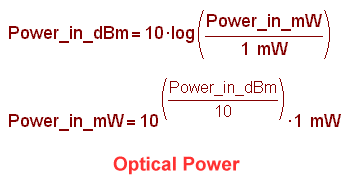
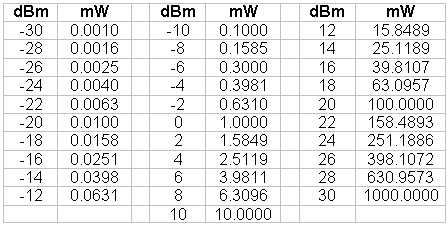 Key Points
Key Points
Negative dBm powers are less than 1 mW
0 dBm is 1 mW
The "logarithmic" nature of the equations means that small increases in dBm can give relatively small or large increases in mW
Gain & Loss
Gain or loss is usually expressed in decibels (dB) and is a change in optical power, not an optical power itself. It relates the input power to the output power, and is given by the following equation.(You should always ensure that both the powers entered into the equation are expressed in the same unit; e.g., both must be in mW or both must be in W, etc.)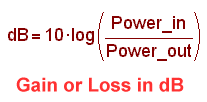 Key Points
Key Points
A gain of 3 dB corresponds to the optical power (in Watts) doubling
A loss of 3 dB (which can also be called a –3 dB gain) corresponds to the optical power in Watts halving
Loss and gain of optical powers can be calculated quickly by just adding or subtracting the dB of gain or loss to the optical power in dBm, e.g:
If an optical power of -2 dBm experiences a gain of 8 dB, the resulting optical power is now 6 dBm
If an optical power of 4 dBm experiences a loss of 9 dB, the resulting optical power is now -5 dBm
Wavelength & Frequency
Wavelength (l = “lambda”) is the distance between two peaks or two troughs of a wave, and is measured in meters (m). The infrared waves used in optical communications have very small wavelengths, usually expressed in nanometers (nm).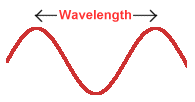 Frequency equals the number of waves that pass a fixed point in one second, designated by the unit of Hertz (Hz). The frequency of a wave is just the speed of light divided by the wavelength (the speed of light is about 300,000 km/s in a vacuum). With this equation you can see that smaller wavelengths have higher frequencies, and longer wavelengths have lower frequencies. Optical communications wavelengths of around 1555 nm relate to frequencies of around 193 THz.
Frequency equals the number of waves that pass a fixed point in one second, designated by the unit of Hertz (Hz). The frequency of a wave is just the speed of light divided by the wavelength (the speed of light is about 300,000 km/s in a vacuum). With this equation you can see that smaller wavelengths have higher frequencies, and longer wavelengths have lower frequencies. Optical communications wavelengths of around 1555 nm relate to frequencies of around 193 THz.
Below is the equation to convert WDM (wavelength-division multiplexing; see Wavelength Division Multiplexing (WDM)) frequency spacings into wavelength spacings. The three figures most often encountered are tabled below, along with some wavelength and frequency conversions for standard WDM channels with 100 GHz spacing.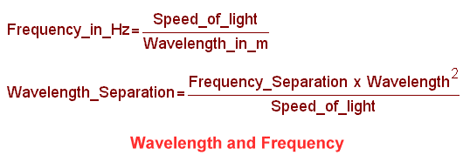
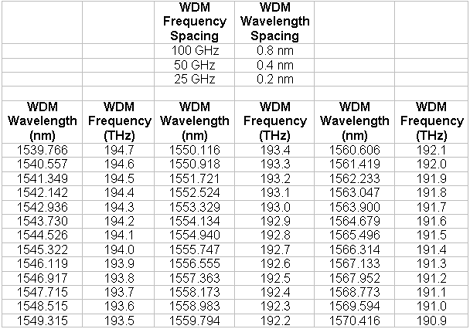 Bandwidth & Optical Modulation Bandwidth
Bandwidth & Optical Modulation Bandwidth
The amount of information that can be transmitted through networks is quoted in bits per second and, more usually, gigabits per second (see Optical Networks). This quantity can be referred to by many different names such as bit-rate, capacity, throughput, and bandwidth. However, there is also another meaning for bandwidth that you should be aware of.
Modulators are devices that switch a light stream passing through them on and off by applying an electrical current to it. This electrical current corresponds to the information that is to be transmitted through the network as 1s and 0s. Modulators have a “bandwidth” associated with them, which can also be referred to by other names such as modulation bandwidth, optical modulation bandwidth, or 3dB modulation bandwidth.
As modulators basically have to switch a light on and off a number of times every second, this is expressed in the frequency units of Hertz (Hz). At very low frequencies (which correspond to low bit-rates of information) modulators perform very well, giving a very clear distinction between 1s (light) and 0s (no light) in their output. As the frequency at which they are driven increases, however, their performance can suffer. A frequency is reached (hopefully many GHz, matching the bit-rate of a system) at which the difference in light power between the 1s and 0s has dropped to half of the value it was at the very low frequencies. This is the so-called “optical modulation bandwidth.” A 50 percent reduction in power corresponds to a 3dB loss (as described in the Gain and Loss section), which is why the figure can also be referred to as “3dB modulation bandwidth.”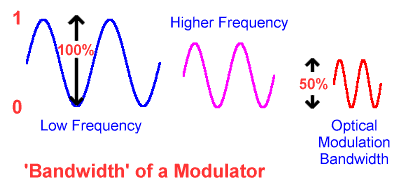 Just to give some ballpark figures, the bandwidth of a 10-Gbit/s modulator may be around 12 GHz, and the figure may be around 30 GHz for a 40-Gbit/s modulator.
Just to give some ballpark figures, the bandwidth of a 10-Gbit/s modulator may be around 12 GHz, and the figure may be around 30 GHz for a 40-Gbit/s modulator.
You May Also Like










